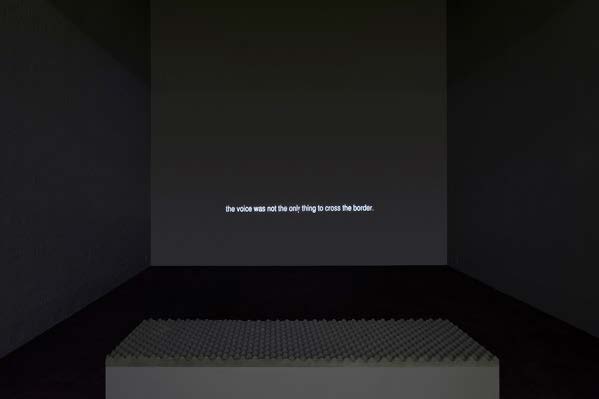Ulises, Philadelphia
April 2017

Abu Hamdan’s adoption of documentary and juridical speech styles, his interest in forensic research, and his frequent treatment of cold and violent topics – borders, law, conflict, prison – make him an unlikely contributor to a conversation on intimacy. Yet I hope, by including him in this quarterly, to open up a tangential line of thought on civic intimacy and conditions of proximity and knowledge, privacy and surveillance.
Closeness, warmth, talk, knowing – these are conditions that we typically associate with intimacy. In their suspension – for example, the imposition of distance by a militarized border fence, cutting through a preexisting community, or the suppression of speech at the silent Saydnaya prison – what shape do human interactions take? And how do subjects and communities perform their relations to the state?
Possibilities for civic intimacy, however these might be articulated and pursued, are furthermore shadowed by the easy mutation of reciprocal knowledge from a condition of intimacy to one of control, and the ambiguity of speech as a vehicle of meaning: we privilege the voice to communicate emotion and love, but its other uses – for example, professional, juridical, or political – often spurn intimacy. For this screening, we present two works: the first, an audio/video piece called Language Gulf in the Shouting Valley (2013) looks at the Druze community inhabiting the border regions between Israel, Palestine, and Syria, examining the status of this religious minority among the broader political ecology of the area and documenting an episode of reunion around, and transgression of, the Israeli border dividing the community. Saydnaya (the missing 19 db) a new work commissioned for the Sharjah Biennial, is an acoustic investigation of Saydnaya prison, operated by the Syrian regime, which has historically been a site of human rights abuses. Since protests against the regime began in 2011 the abuses of Saydnay have intensified and it is estimated that over 13,000 of the prison’s inmates have been executed during the ongoing war. Outsiders are not allowed to visit the prison so the memories of former inmates are the only source from which we might learn of the conditions of Saydnaya.
These two works by Abu Hamdan prompt considerations of intimacy in relation to community, citizenship, and the state, and question our values of disclosure, transparency, reciprocal knowledge, truth in intimate relations.
Organized for Ulises for their quarterly on intimacy.
Image: Lawrence Abu Hamdan, Language Gulf in the Shouting Valley, 2013

This entry is licensed under a Creative Commons Attribution-NonCommercial-ShareAlike 4.0 International license.

